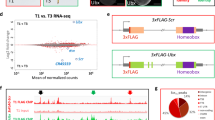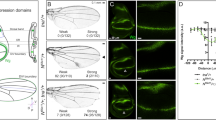Abstract
Tcf/Lef transcription factors mediate signalling from Wingless/Wnt proteins by recruiting Armadillo/β-catenin as a transcriptional co-activator1,2,3,4,5,6,7. However, studies of Drosophila, Xenopus and Caenorhabditis elegans have indicated that Tcf factors may also be transcriptional repressors6,8,9,10,11,12,13. Here we show that Tcf factors physically interact with members of the Groucho family of transcriptional repressors. In transient transfection assays, the Xenopus Groucho homologue XGrg-4 inhibited activation of transcription of synthetic Tcf reporter genes. In contrast, the naturally truncated Groucho-family member XGrg-5 enhanced transcriptional activation. Injection of XGrg-4 into Xenopus embryos repressed transcription of Siamois and Xnr-3, endogenous targets of β-catenin–Tcf. Dorsal injection of XGrg-4 had a ventralizing effect on Xenopus embryos. Secondary-axis formation induced by a dominant-positive Armadillo–Tcf fusion protein was inhibited by XGrg-4 and enhanced by XGrg-5. These data indicate that expression of Tcf target genes is regulated by a balance between Armadillo and Groucho.
This is a preview of subscription content, access via your institution
Access options
Subscribe to this journal
Receive 51 print issues and online access
$199.00 per year
only $3.90 per issue
Buy this article
- Purchase on Springer Link
- Instant access to full article PDF
Prices may be subject to local taxes which are calculated during checkout




Similar content being viewed by others
References
Behrens, J. et al . Functional interaction of β-catenin with the transcription factor LEF-1. Nature 382, 638–642 (1996).
Molenaar, M. et al . XTcf-3 transcription factor mediates beta-catenin-induced axis formation in Xenopus embryos. Cell 86, 391–399 (1996).
Huber, O. et al . Nuclear localization of beta-catenin by interaction with transcription factor LEF-1. Mech. Dev. 59, 3–10 (1996).
Brunner, E., Peter, O., Schweizer, L. & Basler, K. pangolin encodes a Lef-1 homologue that acts downstream of Armadillo to transduce the Wingless signal in Drosophila. Nature 385, 829–833 (1997).
van de Wetering, M. et al . Armadillo coactivates transcription driven by the product of the Drosophila segment polarity gene dTCF. Cell 88, 789–799 (1997).
Riese, J. et al . LEF-1, a nuclear factor coordinating signaling inputs from wingless and decapentaplegic. Cell 88, 777–787 (1997).
Cadigan, K. M. & Nusse, R. Wnt signaling: a common theme in animal development. Genes Dev. 11, 3286–3305 (1997).
Thorpe, C. J., Schlesinger, A., Carter, J. C. & Bowerman, B. Wnt signaling polarizes an early C. elegans blastomere to distinguish endoderm from mesoderm. Cell 90, 695–705 (1997).
Rocheleau, C. E. et al . Wnt signaling and an APC-related gene specify endoderm in early C. elegans embryos. Cell 90, 707–716 (1997).
Lemaire, P. et al . Expression cloning of Siamois, a Xenopus homeobox gene expressed in dorsal-vegetal cells of blastulae and able to induce a complete secondary axis. Cell 81, 85–94 (1995).
Brannon, M., Gomperts, M., Sumoy, L., Moon, R. T. & Kimelman, D. Abeta-catenin/XTcf-3 complex binds to the siamois promoter to regulate dorsal axis specification in Xenopus. Genes Dev. 11, 2359–2370 (1997).
Han, M. Gut reaction to Wnt signaling in worms. Cell 90, 581–584 (1997).
Bienz, M. TCF: transcriptional activator or repressor? Curr. Opin. Cell Biol. 10, 366–372 (1998).
Mallo, M., Franco del Amo, F. & Gridley, T. Cloning and developmental expression of Grg, a mouse gene related to the groucho transcript of the Drosophila Enhancer of split complex. Mech. Dev. 42, 67–76 (1993).
Hartley, D. A., Preiss, A. & Artavanis Tsakonas, S. Adeduced gene product from the Drosophila neurogenic locus, enhancer of split, shows homology to mammalian G-protein beta subunit. Cell 55, 785–795 (1988).
Paroush, Z. et al . Groucho is required for Drosophila neurogenesis, segmentation, and sex determination and interacts directly with hairy-related bHLH proteins. Cell 79, 805–815 (1994).
Parkhurst, S. M. Groucho: making its Marx as a transcriptional co-repressor. Trends Genet. 14, 130–132 (1998).
Fisher, A. L. & Caudy, M. Groucho proteins: transcriptional corepressors for specific subsets of DNA-binding transcription factors in vertebrates and invertebrates. Genes Dev. 12, 1931–1940 (1998).
Jimenez, G., Paroush, Z. & Ish Horowicz, D. Groucho acts as a corepressor for a subset of negative regulators, including Hairy and Engrailed. Genes Dev. 11, 3072–3082 (1997).
Choudhury, B. K., Kim, J., Kung, H. F. & Li, S. S. Cloning and developmental expression of Xenopus cDNAs encoding the Enhancer of split groucho and related proteins. Gene 195, 41–48 (1997).
Pinto, M. & Lobe, C. G. Products of the grg (Groucho-related gene) family can dimerize through the amino-terminal Q domain. J. Biol. Chem. 271, 33026–33031 (1996).
Korinek, V. et al . Two members of the Tcf family implicated in Wnt/β-catenin signaling during embryogenesis in the mouse. Mol. Cell. Biol. 18, 1248–1256 (1998).
Laurent, M. N., Blitz, I. L., Hashimoto, C., Rothbächer, U. & Cho, K. W. Y. The Xenopus homeobox gene Twin mediates Wnt induction of Goosecoid in establishment of Spemann's organizer. Development 124, 4905–4916 (1997).
McKendry, R., Hsu, S. C., Harland, R. M. & Grosschedl, R. LEF-1/TCF proteins mediate wnt-inducible transcription from the Xenopus nodal-related 3 promoter. Dev. Biol. 192, 420–431 (1997).
Harland, R. M. et al . In situ hybridization: an improved whole mount method for Xenopus laevis. Methods Enzymol. 36, 685–697 (1991).
Smith, W. C. & Harland, R. M. Expression cloning of noggin, a new dorsalizing factor localized to the Spemann organizer in Xenopus embryos. Cell 70, 829–840 (1992).
Korinek, V. et al . Constitutive transcriptional activation by a beta-catenin-Tcf complex in APC−/− colon carcinoma. Science 275, 1784–1787 (1997).
Morin, P. J. et al . Activation of beta-catenin-Tcf signaling in colon cancer by mutations in beta-catenin or APC. Science 275, 1787–1790 (1997).
Rubinfeld, B. et al . Stabilization of beta-catenin by genetic defects in melanoma cell lines. Science 275, 1790–1792 (1997).
Kao, K. & Elinson, R. P. The entire mesodermal mantle behaves as Spemann's organizer in dorsoanterior enhanced Xenopus laevis embryos. Dev. Biol. 127, 64–77 (1988).
Acknowledgements
We thank M. Peifer and A. Bejsovec for sharing unpublished information; C. Lobe and K. Koop for Grg cDNAs; S. Stifani for TLE cDNAs and helpful comments; W. C. Smith for Xnr3 and Xnoggin cDNA; D. Kimelman for siamois reporter constructs; and R. Medema for biochemical advice.
Author information
Authors and Affiliations
Corresponding author
Rights and permissions
About this article
Cite this article
Roose, J., Molenaar, M., Peterson, J. et al. The Xenopus Wnt effector XTcf-3 interacts with Groucho-related transcriptional repressors. Nature 395, 608–612 (1998). https://doi.org/10.1038/26989
Received:
Accepted:
Issue Date:
DOI: https://doi.org/10.1038/26989
This article is cited by
-
Status of kinases in Epstein-Barr virus and Helicobacter pylori Coinfection in gastric Cancer cells
BMC Cancer (2020)
-
Wnt signaling in breast cancer: biological mechanisms, challenges and opportunities
Molecular Cancer (2020)
-
The effect of GnRH antagonist cetrorelix on Wnt signaling members in pubertal and adult mouse ovaries
Histochemistry and Cell Biology (2019)
-
The function of tcf3 in medaka embryos: efficient knockdown with pePNAs
BMC Biotechnology (2018)
-
Transcriptional regulation of murine natural killer cell development, differentiation and maturation
Cellular and Molecular Life Sciences (2018)
Comments
By submitting a comment you agree to abide by our Terms and Community Guidelines. If you find something abusive or that does not comply with our terms or guidelines please flag it as inappropriate.



